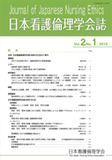Japanese
English
- 販売していません
- Abstract 文献概要
- 参考文献 Reference
- サイト内被引用 Cited by
本研究は、倫理的理想像である「よい看護師」が、日本の看護教育の歴史の中でどのように記述されてきたのかを探究する。明治時代から2006年までの看護の教科書18冊を対象に看護師に求められた特質の記述を内容分析する文献的研究を行った。さらに看護教育の変化によって4つの時代に区分し特質の変遷をみた。その結果、1)人としての特質や人柄、2)知識と技術をもつ専門職としての特質、3)外観・身体的側面を示す特質、4)人との関係性を尊重した特質、の4つに分類された。普遍的な特質は「人としての特質や人柄」と「知識と技術をもつ専門職としての特質」であった。1990年代より、「人との関係性を尊重した特質」が増えた。教科書には、看護師のあり方に焦点をおく「徳の倫理」が生き続けていた。しかし、その記述は研究的知見からのものではないため、今の看護師に求められる特質を研究によって示すことが重要である。
This study takes a historical perspective to examine how characteristics of the good nurse were described in selected influential Japanese nursing textbooks published in 1877-2006. The ethical ideal, the good nurse, reflects nursing values and virtues with implications for today's Japanese nursing education and practice. The major question in this study asked which good nurse characteristics were described in these selected Japanese nursing textbooks. Content analysis was conducted to extract good nurse characteristics from 18 influential Japanese textbooks selected at four historical periods when there was a change in nursing education. Four categories of good nurse characteristics were identified:(1)personality and humanness,(2)knowledge, skill and attitudes of a caring professional,(3)good physical and healthy appearance, and(4)competence to foster nurse-patient interpersonal relationships. Categories found over time were “the nurse's personality and humanness” and “knowledge, skill and attitudes of a caring professional”, Since 1990, increasing emphasis has been placed on the category “competence to foster interpersonal relationships”. While the textbooks have continued to describe virtue ethics, the descriptions of the good nurse were not empirically based. Further study is therefore needed on this important topic.
Copyright © 2010, The Japan Nursing Ethics Associatin. All rights reserved.


